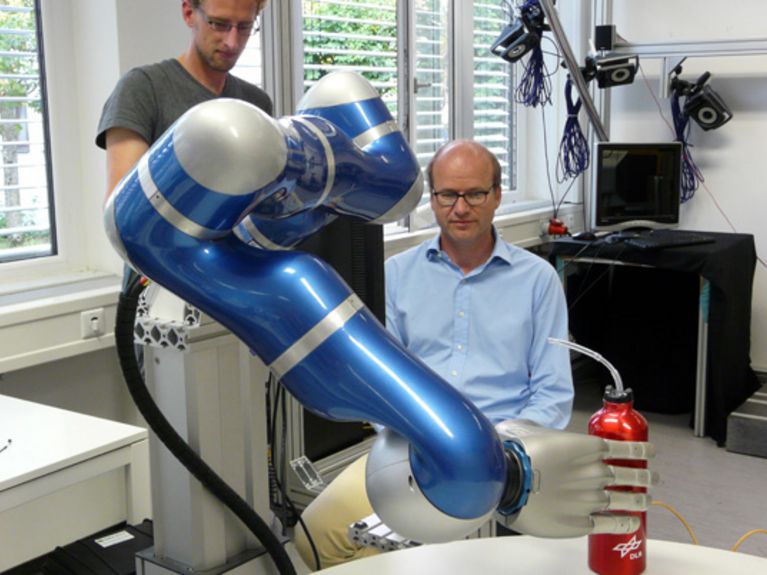Mind-controlled robotic arm awarded prize

Mithilfe einer lernenden Software lässt sich der Roboterarm über Gedanken steuern. Bild: DLR
Prof. Patrick van der Smagt of the German Aerospace Center (DLR) and Prof. John P. Donoghue of Brown University, USA, have been awarded the Erwin Schrödinger Prize 2012 for their work in developing a new type of prosthetic arm that quadriplegics can control with their thoughts. The prize is endowed with €50,000 and is awarded jointly by the Helmholtz Association and Stifterverband für die Deutsche Wissenschaft to recognise outstanding achievements and innovations developed by teams of scientists working across disciplines.
Prof. Patrick van der Smagt of the German Aerospace Center (DLR) and Prof. John P. Donoghue of Brown University, USA, have been awarded the Erwin Schrödinger Prize 2012 for their work in developing a new type of prosthetic arm that quadriplegics can control with their thoughts. The prize is endowed with €50,000 and is awarded jointly by the Helmholtz Association and Stifterverband für die Deutsche Wissenschaft to recognise outstanding achievements and innovations developed by teams of scientists working across disciplines.
The assistive device developed by van der Smagt and Donoghue is a world-first. It allows quadriplegics to control a robotic arm with their thoughts alone and use it to reach out and grasp objects. This is made possible by a specially developed neural interface system - software that translates neural signals from people's brains into commands controlling the robotic arm. In 2011, a woman who is paralysed from the neck down was able to use the arm to retrieve a bottle and drink from a straw - the first time she had served herself since her stroke 15 years earlier. She was able to control the arm without undergoing extensive training, simply by imagining performing the movements with her own arm. Imagining carrying out an action produces signals in the motor cortex, the area of the brain that controls movement.
The team of scientists from Brown University developed a tiny sensor that can be implanted in the motor cortex and transmit these signals to a computer, where a learning algorithm translates them into control signals. The algorithm is continually being improved to produce better results.
Neuroscientists had previously shown that humans could learn to move a computer cursor with their thoughts, but Patrick van der Smagt and his fellow researchers took the next logical step in the development of this technology by proving the feasibility of recreating multidimensional control of complex devices such as a robotic arm directly from neural signals. "This is a technological breakthrough that has attracted considerable international attention and has the real potential to improve quality of life for people with paralysis," says the President of the Helmholtz Association, Prof. Jürgen Mlynek. "The close collaboration between neuroscientists, robotics experts and software developers that made this achievement possible is an impressive example of the power of an interdisciplinary approach."
Prof. Mlynek and the German Federal Minister of Education and Research, Prof. Annette Schavan, will jointly present the Erwin Schrödinger Prize to the recipients at the annual meeting of the Helmholtz Association on 20 September 2012. There will be an opportunity to photograph the award winners and speakers directly after the award ceremony.
Further information:
www.helmholtz.de/schroedingerpreis2012 (in German)
Video "Paralysed woman controls DLR-developed robotic arm with her thoughts"
The prize
The Helmholtz Association and Stifterverband für die Deutsche Wissenschaft have been conferring the Erwin Schrödinger Prize since 1999. Named after physicist Erwin Schrödinger, the prize is awarded in recognition of outstanding scientific and technological achievements in areas of convergence between medicine, the natural sciences and engineering. It is endowed with €50,000, which recipients may use as they wish. The prize is awarded once a year, with funding provided by the Helmholtz Association and Stifterverband für die Deutsche Wissenschaft in alternating years.
Readers comments